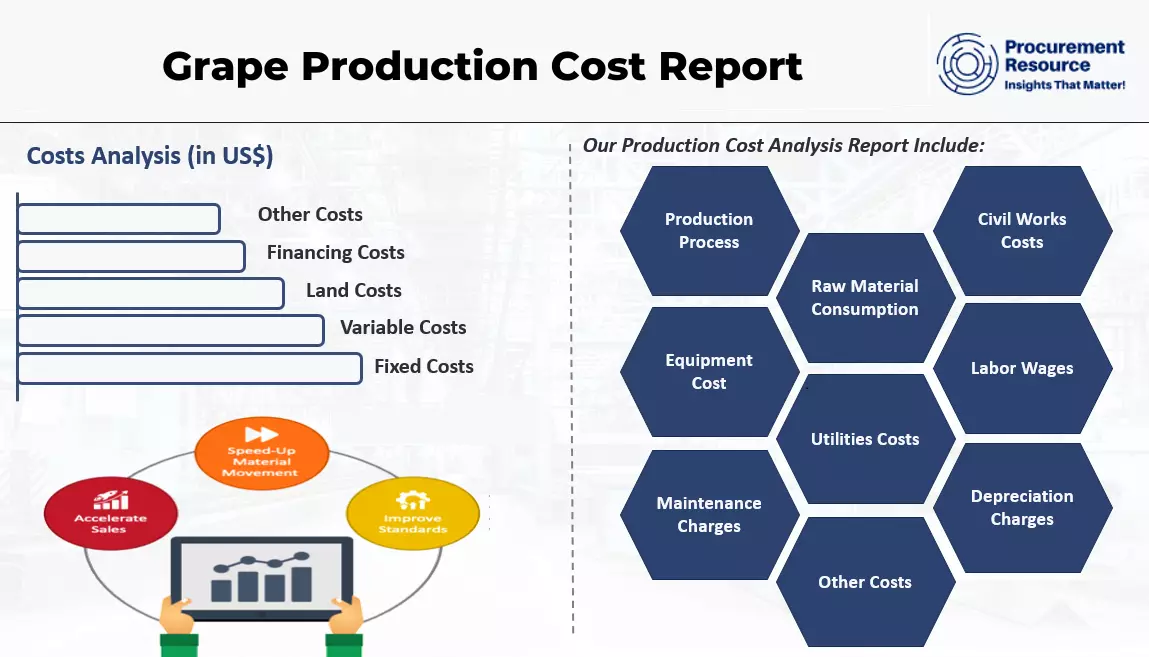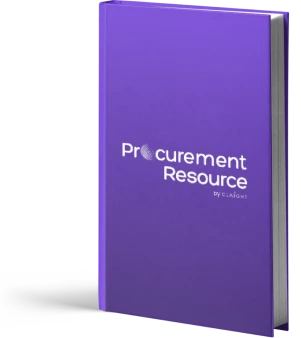Grape Production Cost Reports
Agriculture, Farming and Commodity
The report provides a detailed production cost analysis for Grape. It encompasses all critical aspects necessary for Grape production, including the cost of Grape production, Grape production cost model, and other extensive details. These encompass production processes, raw material requirements, utility requirements, infrastructure needs, machinery and technology requirements, manpower requirements, packaging requirements, transportation requirements, and more.

Grape is a round, sweet, sour-tasting fruit variety that is mainly used in the food and beverages industry. Grapes with higher glucose content ferment faster than other types. They are chiefly used to produce wines by fermenting Grape juice under controlled conditions. Different techniques and processes yield various grape wines, each with a distinct taste. Dried Grapes are commonly known as raisins, used in many culinary applications, including baking and cooking. Additionally, it is in the food industry to produce items like Grape juice, flavored ice creams, and more.
The demand for grapes as a fruit in the food and beverages industries, strengthens its market growth. Its applications for the production of beverage varieties, including wines, beers, etc., fuel its demand in the beverages sector. Its sweet and sour taste in processed food varieties, including spreads, sauces, jams, cakes, cookies, and pies, increases its demand in the market.
Industrial grapes procurement is strongly influenced by the changes in its demand as a fruit variety. Moreover, other factors such as the weather conditions, production, distribution, and market prices of grapes directly impact its procurement across various regions. Hence, the fluctuations in its demand, mainly as a fruit or ingredient for food and wine production, along with its prices, govern its procurement in the global market.
Raw Material for Grape Production
According to the grape production cost report, the key raw material for grape production includes grape seeds.
Manufacturing Process of Grape
The extensive grape production cost report consists of the major industrial manufacturing process:
- By Agricultural Method: Grape is a fruit variety produced from its seeds. The seeds are sown, harvested, cleaned, and supplied for commercial applications.
Grape is a sweet-tangy berry variety that mainly belongs to the Vitaceae family. These are clustered on the fruit-bearing vines and are the primary ingredient in winemaking. It has great commercial value due to its tangy taste and is largely utilized in the beverages industry. Grapes are found in various colors, such as black, yellow, green, red, pink, and more. They come in both seeded and seedless varieties. The fruit is rich in antioxidants and nutrient content, primarily consisting of vitamin C, vitamin K, copper, vitamin B1, vitamin B2, vitamin B6, potassium, manganese, and vitamin E.
The vines grow vigorously and produce Grape clusters. Grapevines are typically planted during early spring after the risk of frost has passed. They thrive in well-drained soil with sunny weather and adequate wind flow. Being climbers, they grow upward when provided with support. Keeping the vines off the ground can prevent fungal diseases.
Several diseases can affect yield, including Aphids, Japanese Beetles, Powdery Mildew, and Black Rot. While the plant takes a few years to mature, once established, it can produce fruit for around thirty years or more. It contains minerals like calcium and phosphorus, along with glucose and fructose in varying quantities, depending on the variety. Hence, can be used to produce healthy processed and packaged food and beverages varieties.
Grape Production Cost Processes with Cost Analysis

Grape Production by Agricultural Methods
This study analyzes Grape Production by Agricultural Methods, covering manufacturing, process flow, operating expenses, and financial considerations.
Details: Germany - based plant Q1 2025 From $ 2499.00 USD
Product Details
| Particulars | Details |
|---|---|
| Product Name | Grape |
| Scope | Manufacturing Process: Process Flow, Material Flow, Material Balance Raw Material and Product Specifications: Raw Material Consumption, Product and Co-product Generation Land and Site Cost: Offsites/Civil Works, Equipment Cost, Auxiliary Equipment Costs, Contingency, Engineering and Consulting Charges, Working Capital Variable Cost: Raw Material, Utilities, Other Variable Costs Fixed Cost: Labor Requirements and Wages, Overhead Expenses, Maintenance Charges, Other Fixed Costs Financing Costs: Interest on Working Capital, Interest on Loans Other Costs: Depreciation Charges, General Sales and Admin Cost |
| Currency | US$ (Data can also be provided in the local currency) |
| Pricing and Purchase Options | Basic: US$ 2499 Premium: US$ 3499 Enterprise: US$ 4799 |
| Customization Scope | The report can be customized as per the requirement of the customer |
| Post-Sale Analysts Report | 10-12 weeks of post-purchase analyst support after report delivery for any queries from the deliverable |
| Delivery Format | PDF and Excel format through email (editable version in PPT/Word format of the report can be also provided on special request) |
How does our Grape Production Cost Report Provide Exhaustive Data and Extensive Insights?
At Procurement Resource, we not only focus on optimizing the should cost of production for Grape but also provide our clients with extensive intel and rigorous information on every aspect of the production process. By utilizing a comprehensive cost model, we help you break down expenses related to raw materials, labor, and technology, offering clear pathways to savings. We also assist in evaluating the capital expenditure (CAPEX) and operating expenses (OPEX), which are often measured as cost per unit of production, such as USD/MT, ensuring that your financial planning is aligned with industry benchmarks.
We offer valuable insights on the top technology providers, in-depth supplier database, and best manufacturers, helping you make informed decisions to improve efficiency. Additionally, we design the most feasible layout for your production needs, ensuring the entire process runs smoothly. By minimizing the cash cost of production, we ensure that you stay competitive while securing long-term profitability in the growing Grape market. Partnering with Procurement Resource guarantees that every aspect of your production is cost-efficient, advanced, and tailored to your specific requirements.
Key Questions Answered in This Report
- How is Grape produced?
- What is the process flow involved in producing Grape?
- What are the raw material requirements and costs for producing Grape?
- What is the total size of land required for setting Grape production?
- What are the production requirements for Grape?
- What are the machinery requirements for producing Grape?
- What are the utility requirements and costs for producing Grape?
- What are the manpower requirements for producing Grape?
- What are the average salaries/wages of manpower for Grape production?
- What are the packaging requirements and associated costs for Grape?
- What are the transportation requirements and associated costs for Grape?
- What are the capital costs for Grape production?
Need more help?
- We can tailor the report as per your unique requirements such as desired capacity, future expansion plans, product specifications, mode of financing, plant location, etc.
- We can also provide a flexible, easy-to-use, dynamic excel-based cost-model/ dashboard where you can change the inputs to get different outputs
- Speak to our highly skilled team of analysts for insights on the recent trends and innovations, industry best practices, key success and risk factors, product pricing, margins, return on investment, industry standards and regulations, etc.
- Gain an unparalleled competitive advantage in your domain by understanding how to optimize your business operations and maximize profits
- For further assistance, please connect with our analysts
Compare & Choose the Right Report Version for You

You can easily get a quote for any Procurement Resource report. Just click here and raise a request. We will get back to you within 24 hours. Alternatively, you can also drop us an email at sales@procurementresource.com.
RIGHT PEOPLE
At Procurement Resource our analysts are selected after they are assessed thoroughly on having required qualities so that they can work effectively and productively and are able to execute projects based on the expectations shared by our clients. Our team is hence, technically exceptional, strategic, pragmatic, well experienced and competent.
RIGHT METHODOLOGY
We understand the cruciality of high-quality assessments that are important for our clients to take timely decisions and plan strategically. We have been continuously upgrading our tools and resources over the past years to become useful partners for our clientele. Our research methods are supported by most recent technology, our trusted and verified databases that are modified as per the needs help us serve our clients effectively every time and puts them ahead of their competitors.
RIGHT PRICE
Our team provides a detailed, high quality and deeply researched evaluations in competitive prices, that are unmatchable, and demonstrates our understanding of our client’s resource composition. These reports support our clientele make important procurement and supply chains choices that further helps them to place themselves ahead of their counterparts. We also offer attractive discounts or rebates on our forth coming reports.
RIGHT SUPPORT
Our vision is to enable our clients with superior quality market assessment and actionable evaluations to assist them with taking timely and right decisions. We are always ready to deliver our clients with maximum results by delivering them with customised suggestions to meet their exact needs within the specified timeline and help them understand the market dynamics in a better way.
SELECT YOUR LICENCE TYPE
- Review the available license options and choose the one that best fits your needs. Different licenses offer varying levels of access and usage rights, so make sure to pick the one that aligns with your requirements.
- If you're unsure which license is right for you, feel free to contact us for assistance.
CLICK 'BUY NOW'
- Once you've selected your desired report and license, click the ‘Buy Now’ button. This will add the report to your cart. You will be directed to the registration page where you’ll provide the necessary information to complete the purchase.
- You’ll have the chance to review your order and make adjustments, including updating your license or quantity, before proceeding to the next step.
COMPLETE REGISTRATION
- Enter your details for registration. This will include your name, email address, and any other necessary information. Creating an account allows you to easily manage your orders and gain access to future purchases or reports.
- If you already have an account with us, simply log in to streamline the process.
CHOOSE YOUR PAYMENT METHOD
- Select from a variety of secure payment options, including credit/debit cards, PayPal, or other available gateways. We ensure that all transactions are encrypted and processed securely.
- After selecting your payment method, you will be redirected to a secure checkout page to complete your transaction.
CONFIRM YOUR PURCHASE
- Once your payment is processed, you will receive an order confirmation email from sales@procurementresource.com confirming the dedicated project manger and delivery timelines.
ACCESS YOUR REPORT
- The report will be delivered to you by the project manager within the specified timeline.
- If you encounter any issues accessing your report, project manager would remain connected throughout the length of the project. The team shall assist you with post purchase analyst support for any queries or concerns from the deliverable (within the remit of the agreed scope of work).
